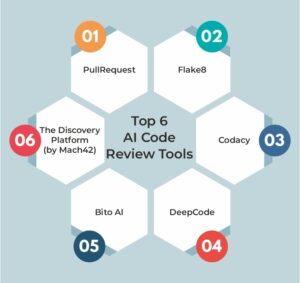The web development field is advancing at a rapid pace. Developers around are working constantly to build applications that make an impact. But yeah, you spend hours writing code, only to wait for your manager to review it.
This is tiresome and takes a lot of time. Do you receive 100% assurance that the code is correct, or might there be a risk if they miss a critical issue that could disrupt the production phase? You’re not the only one facing this!
For all the savvy developers, code review is the only barrier to productivity. It takes a lot of time and effort to achieve the same results. Here comes the AI code review tools, making the job simpler. As the name suggests, these are intelligent assistants that help identify faults, boost review cycles, and perform additional tasks.
In this blog, we’ll walk through the top 6 code review tools that will help you make your web development journey easy and efficient.
AI Code Review Tools in Short
AI code review tools are software applications that leverage AI to identify and resolve bugs, errors, security vulnerabilities, and other code issues. As discussed above, human reviewers can mistakenly miss out on a critical issue that the AI Code Review platform won’t.
Instead, it offers suggestions before code is put into production, errors are fixed, and areas that require attention are flagged. Whether you are an individual developer or part of the Big 4, these tools are here to help you review code that makes a difference.
Why AI Code Review Matters?
The use of AI code review tools extends beyond checking errors to accelerate web development, deliver correctness, and boost the overall productivity of development teams.
The AI Code review tools ease the manual work, highlight the high-risk codes, and integrate seamlessly into workflows.
The following are a few reasons why AI Code Review matters:
- Increase review coverage while maintaining release speed.
- Reduce the security flaws and performance issues.
- Reduce the workload for senior engineers to focus on innovation rather than error detection.
- Boost teamwork and confidence among developers.
Manual review is a tiresome job, as discussed above. Fortunately, there are popular and trusted AI Code review tools available that will streamline the development process by ensuring quality, speed, and accuracy all at once.
Let’s take a look at the top 6 AI Code review tools:
1. PullRequest
The tool is ideal for teams of all sizes looking for the best combination of AI and expert human assessment.
PullRequest provides influential code reviews by combining its engineering know-how with AI. PullRequest supports a wide range of libraries, execution environments, and languages and integrates seamlessly with current development workflows.
Below are some of the key features of PullRequest:
- AI-generated insights: By accurately identifying potentially dangerous code, AI frees up reviewers’ time to concentrate on the most crucial sections.
- Well-trained employees: Senior engineers from top software firms work at PullRequest, sharing best practices and mentoring teams.
- Focus on security and performance: The platform excels at identifying vulnerabilities and improving performance before deployment.
- Workflow integration: Provides developers with a simple experience by integrating with GitHub, GitLab, and other CI/CD pipelines.
2. Flake8
The next on the list of AI code review platforms is Flake8. The tool is best suited for SMBs and Python teams, offering style consistency and easy error detection.
Flake8, a Python-based linting tool, is both lightweight and powerful. It is here to make your workflow a breeze. Although it’s not as advanced as some AI-driven platforms, it is widely used for ensuring style consistency and detecting basic mistakes.
A few key features of Flake8:
- Flake8 can be easily and quickly integrated into teams’ workflows.
- A wide range of plugins is available within the plugin ecosystem for extending its checks, from complex analysis to security testing.
- Maintains style standards and ensures code is consistent and readable.
- For smaller teams or Python-focused projects, Flake8 is a cost-effective way to keep the code simple and of good quality.
3. Codacy
For teams with multiple languages, the most suitable option is to incorporate automated reviews into workflows. Codacy’s automated code reviews support popular programming languages like Python, JavaScript, PHP, and Java. Efforts to ensure smooth onboarding and integration into the development lifecycle are its main strength.
- Regular inspections: Detects errors in code style, security weaknesses, and copying.
- Permanent tracking: Keeps tabs on all commits and pull requests while in the background.
Codacy automates routine review tasks, enabling developers to identify issues before they occur, reduce the need for rework, and maintain project speed.
4. DeepCode
DeepCode, a recently added feature from Snyk, uses AI models to evaluate your code in real time. Beyond style enforcement, DeepCode’s main goal is to provide useful insights that assist developers stay safe by avoiding frequent errors and security flaws. Teams and open-source projects seeking real-time AI insights favor it.
- Utilizes AI-driven analysis to gain insight from open-source projects and provide context-aware recommendations.
- IDE or repository delivers insights in real-time feedback.
- Promoting the best practices by promoting improved design habits and coding skills.
The combination of speed and depth in analysis allows DeepCode to help teams ship code with improved quality.
5. Bito AI
Bito comes with an AI-powered coding assistant that guides developers through the software’s lifespan and beyond. For developers looking for an AI assistant that integrates seamlessly with their IDE or CLI, this is the greatest option.
- Assistance with code reviews: Recognizes security flaws, performance issues, and logical errors.
- Support for natural language usage: Developers can seek answers in plain English and receive guidance on syntax, structure, and best practices.
- Workflow integration: Works with both GitHub and GitLab, with expansion plans.
Bito functions as a virtual engineer within the team, saving time, improving developer knowledge, and strengthening codebases.
6. The Discovery Platform (by Mach42)
The Discovery Platform of Mach42 is not only dedicated to simulation acceleration but also makes significant advancements in code verification and review. With its neural network technology, expensive calculations are automated, and data is retrieved with high accuracy. High-powered teams attempting to solve complex simulations and engineering software.
- The use of AI-driven verification expedites verification tasks.
- Allows teams to test more scenarios without bottlenecking.
- Businesses in fields like semiconductors, physics, and advanced engineering can benefit from the potential for scale.
- Ensures logical and numerical integrity at scale.
Wrapping it Up!
Simply writing down code is only halfway to completing the job. The real test lies in reviewing the code and finding the errors. In this scenario, manual code reviewing can be a significant hassle. Thus, the above-mentioned AI code review tools can be a game-changer for your development journey. Good luck with the same!
You don’t want to miss all the trending blog updates. Check out our blog section today for the same.
Frequently Asked Questions
Q1. Can you use AI to do code reviews?
Yes! You can use AI code review is all about integrating agentic AI to identify issues, suggest improvements and also work on fixing common bugs in the code.
Q2. What are the differences between AI and conventional code review tools?
Here is the basic difference between AI powered and traditional code review tools.
While AI-powered technologies ease the process by scanning code for bugs, vulnerabilities, style problems, and performance bottlenecks, traditional code reviews still rely on manual review.
Read More:
How Low Code Workflow Automation helps Businesses?
How Low-Code and No-Code Platforms Are Changing Software Development



